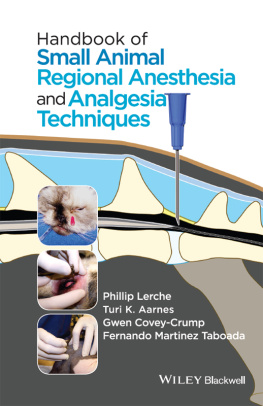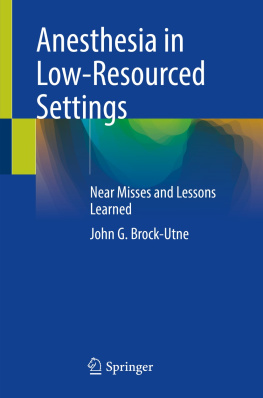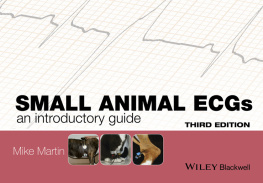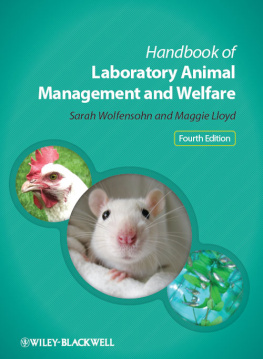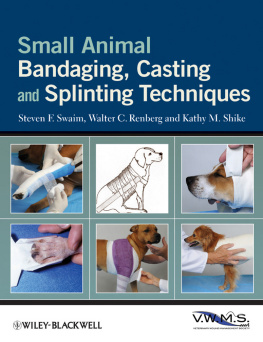
Handbook of Small
Animal Regional
Anesthesia and
Analgesia Techniques
Phillip Lerche BVSc PhD DipACVAA
Associate Professor Clinical
Anesthesiology and Pain Management
Department of Veterinary Clinical Sciences
The Ohio State University
College of Veterinary Medicine
Columbus, Ohio, USA
Turi K. Aarnes DVM MS DipACVAA
Associate Professor Clinical
Anesthesiology and Pain Management
Department of Veterinary Clinical Sciences
The Ohio State University
College of Veterinary Medicine
Columbus, Ohio, USA
Gwen Covey-Crump BVetMed CertVA DipECVAA MRCVS
Specialist in Veterinary Anaesthesia and Analgesia
Clinical Teacher
Langford Veterinary Services
University of Bristol
Bristol, UK
Fernando Martinez Taboada LV CertVA DipECVAA MRCVS
Specialist in Veterinary Anaesthesia and Analgesia
The Veterinary Teaching Hospital
Faculty of Veterinary Science
The University of Sydney
Sydney, Australia
This edition first published 2016 2016 by John Wiley & Sons, Ltd
Registered office:
John Wiley & Sons, Ltd, The Atrium, Southern Gate, Chichester, West Sussex, PO19 8SQ, UK
Editorial offices:
9600 Garsington Road, Oxford, OX4 2DQ, UK The Atrium, Southern Gate, Chichester, West Sussex, PO19 8SQ, UK 1606 Golden Aspen Drive, Suites 103 and 104, Ames, Iowa 50010, USA
For details of our global editorial offices, for customer services and for information about how to apply for permission to reuse the copyright material in this book please see our website at www.wiley.com/wiley-blackwell
The right of the author to be identified as the author of this work has been asserted in accordance with the UK Copyright, Designs and Patents Act 1988.
All rights reserved. No part of this publication may be reproduced, stored in a retrieval system, or transmitted, in any form or by any means, electronic, mechanical, photocopying, recording or otherwise, except as permitted by the UK Copyright, Designs and Patents Act 1988, without the prior permission of the publisher.
Designations used by companies to distinguish their products are often claimed as trademarks. All brand names and product names used in this book are trade names, service marks, trademarks or registered trademarks of their respective owners. The publisher is not associated with any product or vendor mentioned in this book. It is sold on the understanding that the publisher is not engaged in rendering professional services. If professional advice or other expert assistance is required, the services of a competent professional should be sought.
The contents of this work are intended to further general scientific research, understanding, and discussion only and are not intended and should not be relied upon as recommending or promoting a specific method, diagnosis, or treatment by health science practitioners for any particular patient. The publisher and the author make no representations or warranties with respect to the accuracy or completeness of the contents of this work and specifically disclaim all warranties, including without limitation any implied warranties of fitness for a particular purpose. In view of ongoing research, equipment modifications, changes in governmental regulations, and the constant flow of information relating to the use of medicines, equipment, and devices, the reader is urged to review and evaluate the information provided in the package insert or instructions for each medicine, equipment, or device for, among other things, any changes in the instructions or indication of usage and for added warnings and precautions. Readers should consult with a specialist where appropriate. The fact that an organization or Website is referred to in this work as a citation and/or a potential source of further information does not mean that the author or the publisher endorses the information the organization or Website may provide or recommendations it may make. Further, readers should be aware that Internet Websites listed in this work may have changed or disappeared between when this work was written and when it is read. No warranty may be created or extended by any promotional statements for this work. Neither the publisher nor the author shall be liable for any damages arising herefrom.
A catalogue record for this book is available from the Library of Congress and the British Library.
ISBN: 9781118741825
Wiley also publishes its books in a variety of electronic formats. Some content that appears in print may not be available in electronic books.
Main cover image: with permission from The Ohio State University
CHAPTER 1
Introduction
Phillip Lerche
Reasons to provide regional anesthesia
The use of regional anesthesia as a component of perioperative pain management has gained acceptance and popularity in small animal practice over the past few decades. Reasons for this include the fact that many of the regional blocks are straightforward to perform, requiring moderate technical skill given familiarity with patient anatomy; they can be conducted relatively safely given an understanding of local anesthetic drug pharmacology, complications and side effects; and they contribute to the two major tenets of treating pain: pre-emptive and multimodal analgesia.
Providing pre-emptive analgesia by performing regional anesthesia prior to surgery leads to a drastic reduction in intraoperative nociceptive (pain) stimulation. This results in a decrease in anesthetic maintenance drug as well as intra- and postoperative analgesic requirements, thereby decreasing the incidence of drug side effects during surgery, and improving postoperative patient comfort as well as duration of pain relief. Some techniques can be continued postoperatively to assist in managing pain after particularly painful surgeries once the patient has recovered from anesthesia, e.g. instilling local anesthetic into a chest tube after thoracotomy, or injecting local anesthetic into an epidural or spinal catheter after pelvic limb or abdominal surgery.
The experience of pain, a sensory process involving the nociceptive pathway, is complex, and involves several steps. Noxious stimuli involving mechanical, chemical or thermal injury to tissue are first transduced into electrical stimuli by peripheral nociceptors (pain receptors). These electrical impulses are then transmitted to the spinal cord, where they are modulated by neurons in the dorsal horn of the gray matter of the spinal cord. Here, impulse intensity can be increased (amplified) or decreased (suppressed). Finally, the nociceptive signals are projected via lateral nerve fibers to the brain where they are perceived.
Whereas most analgesic drugs either decrease the amount of excitatory neurotransmitters, or increase the level of inhibitory neurotransmitters released in the nociceptive pathway, drugs used to provide regional anesthesia block sodium channels in neurons. This completely prevents sensory neurons from transmitting noxious stimuli from the periphery to the brain and spinal cord, or from the spinal cord to the brain in the case of epidural or spinal analgesia, thus providing effective pain relief for the duration of the block. Using regional anesthetic techniques in conjunction with other analgesic drugs that act in different ways on the nociceptive fibers (e.g. with opioids, alpha-2 agonists, ketamine) results in multimodal analgesia, contributing to an overall decrease in excitatory neurotransmission within the pain pathway both during and after surgery. This approach allows for the lowest effective dose of each drug to be used, which decreases side effects and enhances patient safety.
Next page
